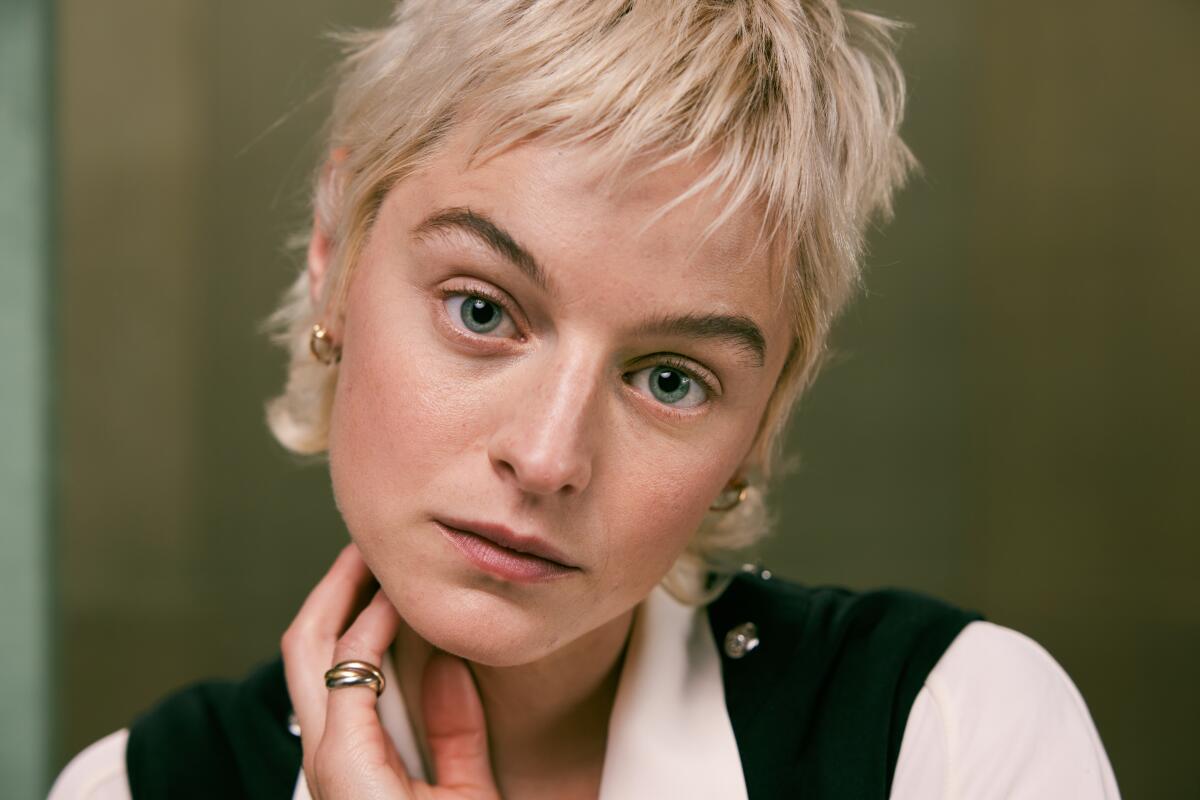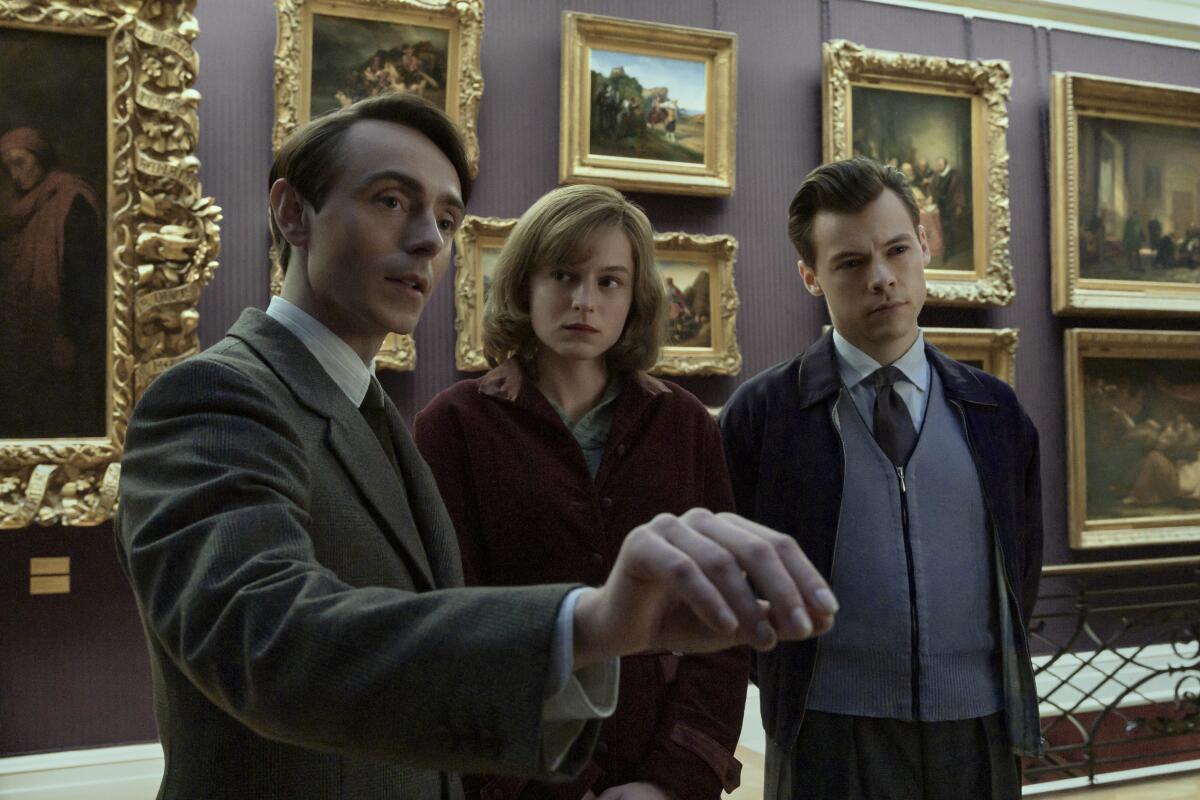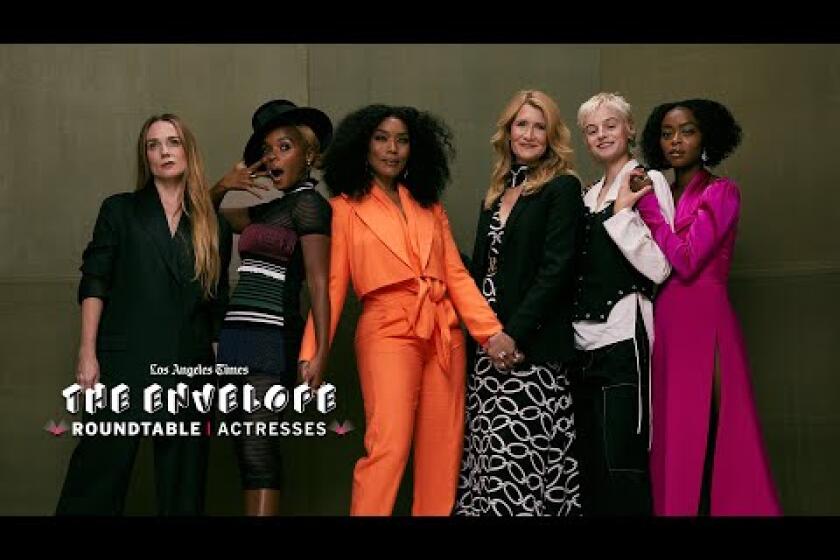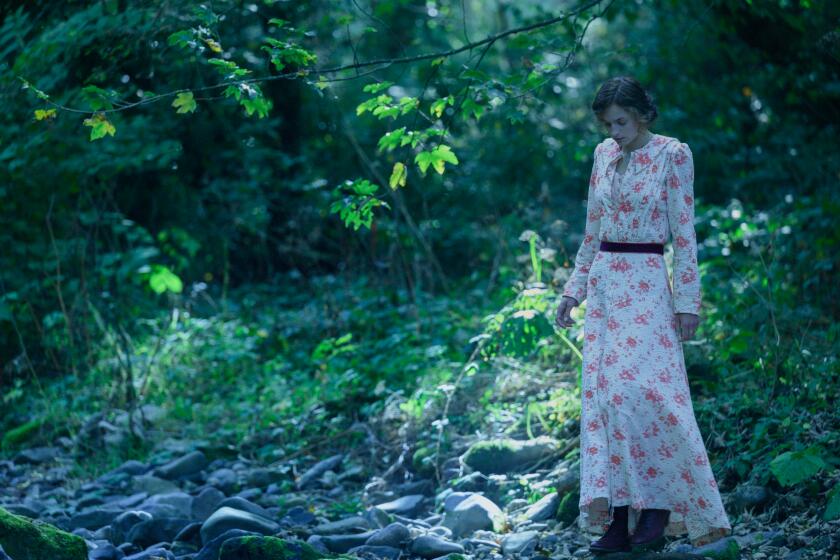With two films involving love triangles, Emma Corrin explores freedom and repression

- Share via
In “My Policeman” and “Lady Chatterley’s Lover,” Emma Corrin plays two very different characters. Initially, the British actor was concerned the stories, both period films centering on a love triangle, would feel too similar, but as Corrin became more immersed in the roles, each journey became a distinct experience. In “My Policeman,” Marion Taylor is grappling with prejudice in 1950s Brighton as she discovers her new husband might be gay, while Connie in “Lady Chatterley’s Lover” uncovers her latent sexuality with the help of the estate’s groundskeeper.
“It’s almost like Connie is who you want Marion to be but she’s not,” says Corrin, who uses they/them pronouns. “They turned out to be very different, which was really nice to realize that no two stories are the same. No two people are the same, even though some elements of what they’re going through might be.”
Corrin shot “My Policeman,” an adaptation of the Bethan Roberts novel, first. They were attracted by the prospect of working with director Michael Grandage (who will reunite with Corrin for a West End production of “Orlando” in November), as well as how current the storyline felt.
“When I got the script, I thought the writing was so beautiful and thought the interweaving of perspectives and how it deals with memory was so interesting,” Corrin remembers. “It’s a real exploration into the way our memories still have control of us when we’re older and how our perception of the truth changes or doesn’t change as we get older. I was curious about it. And I was curious about Marion. I think she’s very complex, and that was something I was really willing to explore.”
Bassett, Monáe, Emma Corrin, Kerry Condon, Danielle Deadwyler and Laura Dern open up about the benefits of intimacy coordinators and channeling pain.
Before shooting the film on location last spring, Grandage held three weeks of rehearsals for Corrin, Harry Styles and David Dawson. It was important for the actors to find the intimate relationship between Marion, her husband Tom and his lover Patrick, who is also Marion’s close friend. The foundation of that relationship is what allows Marion’s eventual betrayal of it to feel so poignant and conflicted.
“We had a lot of conversations about how we wanted to make all the moments where it’s the three of them infused with so much joy and togetherness,” Corrin says. “Because then you really understand the fallout of it and how it hurts this group of friends. [She’s] a young woman who doesn’t understand society and the way it works and doesn’t understand anything about Patrick’s life or the real lived experiences of queer people at that time. She has no idea. She’s reacting from the basis of what she knows and how that makes her feel.”

Playing someone like Marion, who is rooted in societal prejudice, was a challenge for Corrin, who identifies as queer. But it was a role that felt authentic to the actor.
“You had to approach it with empathy and that was really interesting,” Corrin says. “But that’s life, isn’t it? I thought that it was very real in its portrayal of people’s flaws. No one in the film is perfect and yet they muddle on, which we do.”
Almost immediately afterward, Corrin went to Wales to shoot “Lady Chatterley’s Lover,” a new adaptation of D.H. Lawrence’s controversial 1928 novel. The story centers on Constance Reid, a woman whose upper-class husband becomes paralyzed from the waist down in World War I, leaving her feeling physically and emotionally isolated. She finds solace with Oliver (played by Jack O’Connell), tapping into a sexual confidence that comes to define her sense of self. This version, from director Laure de Clermont-Tonnerre, goes all in on the nudity and sex, an aspect of the film that both attracted and terrified Corrin.
As Lady Chatterley sheds the repression of the era, her clothes get lighter and freer, notes costume designer Emma Fryer.
“The scene that really popped for me [when I read it] was the dancing in the rain scene,” Corrin recalls. “It scared me when I read it, and I thought, ‘For that reason alone, I’m in.’ Because what a challenge, and I trusted Laure. If you’re going to do that extensive nudity and make yourself that vulnerable, you’ve got to know that you’re working with someone who you admire and who you trust.”
To prepare for the role, Corrin worked with movement coach Polly Bennett, with whom they’d collaborated on “The Crown,” as well as an intimacy coordinator. But when it came time to shoot the rain scene, where Connie and Oliver gleefully run naked into a storm, Corrin and O’Connell did it without any rehearsal to help capture the energy of the moment.

“There is no faking what that feels like,” Corrin notes. “You are just terrified. And you’re freezing. And it’s exhilarating. It was so much adrenaline and it was beautiful. I remember us like catching each other’s eyes and the pure terror in both of our eyes and knowing that all you have is each other in that moment and you’ve just got to go for it.”
For Corrin, who recently wrapped filming on the FX series “The Retreat,” there was something very freeing about playing both characters. After the intensity of embodying Princess Diana on “The Crown,” it was a relief to leave real-world preparation behind and allow for more spontaneity.
“I had the books, but I didn’t have anything else to draw on and it made me feel anxious to begin with,” Corrin recalls. “Because I suppose I was used to having a wealth of resources and a researcher there. But actually, there’s so much freedom. You really just have to follow your intuition with these characters, which is why it’s so important to do stories that you really believe in and really feel connected to. To just see what comes up. I think, increasingly, I enjoy being surprised by where a scene takes you on the day.”
More to Read
From the Oscars to the Emmys.
Get the Envelope newsletter for exclusive awards season coverage, behind-the-scenes stories from the Envelope podcast and columnist Glenn Whipp’s must-read analysis.
You may occasionally receive promotional content from the Los Angeles Times.











